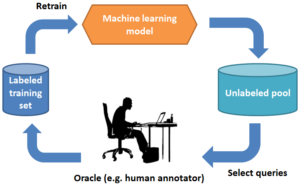The pandemic certainly limits the possibilities for many researchers to have personal contacts– but at the same time offers new opportunities due to the rise of regular video calls, virtual secondments and far distance collaborations with online tools. One positive example is the successful collaboration of the research groups of the Universidad de Granada and Northwerstern University that recently led to our conference presentation at the prestigious MICCAI conference.
Now we got the opportunity to extend this collaboration with my virtual secondment from the 22.11.2021 until 21.12.2021. The expertise in medical images, probabilistic deep learning and computer aided diagnosis of the involved researchers is a strong basis to start new interesting projects together. As the shortage of labeled data is a common problem of many medical image domains, two research areas were of special interest to alleviate this burden: Multiple Instance Learning (MIL) and Active Learning (AL).
The first technique, MIL, requires less annotations, because it groups instances into bags and only requires the bag labels for training. One focus of the secondment lied on hemorrhage detection with CT scans using probabilistic deep learning models in the MIL setting. In this case, the complete CT scan of a patient is treated as a bag while the slices form the instances. MIL applications can also be applied to problems of histopathology, where a Whole Slide Image (WSI) is commonly used as a bag while extracted smaller image patches serve as the instances. Due to the methodological similarity, the developed methods are of high relevance for the CLARIFY project. Based on the combination of Convolutional Neural Networks (CNNs) with Gaussian Processes (GPs), new methods should achieve a better performance for the most accurate diagnosis possible.
Another focus of the secondment was AL. The goal of AL is that the machine learning algorithm itself decides which annotations provide the highest amount of information for the learning process, as shown in Figure 1. Therefore the annotation process reduces to annotating the really important images which can reduce the overall labeling effort. In this line we started a joint research project about AL for histopathological images. One major focus of this project is probabilistic deep learning models, more specifically Bayesian Neural Networks (BNNs). These models allow an uncertainty quantification of the predictions because their output is of probabilistic nature. In the context of AL, this uncertainty can be used to determine images that should be annotated by pathologists.
Figure 1: The process of active learning: The machine learning model selects images to be annotated. With the newly annotated images, the model is retrained and can again selects images for annotation, etc.
Arne Schmidt – ESR8


